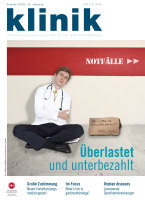Melden Sie sich bitte hier kostenlos und unverbindlich an, um den Inhalt vollständig einzusehen und weitere Services von www.medmedia.at zu nutzen.
Chronisch rezidivierende Harnwegsinfekte: Diagnose und Management

Universitätsklinik für Urologie, Comprehensive Cancer Center, Medizinische Universität Wien – Allgemeines Krankenhaus der Stadt Wien
Foto: Felicitas Matern
AutorIn: Ass.-Prof. Dr. Harun Fajkovic
Universitätsklinik für Urologie, Comprehensive Cancer Center, Medizinische Universität Wien – Allgemeines Krankenhaus der Stadt Wien
Literatur
1 Foxman B et al., Urinary tract infection: self-reported incidence and associated costs. Ann Epidemiol 2000; 10:509–15
2 Foxman B, Recurring urinary tract infection: incidence and risk factors. Am J Public Health 1990; 80:331–3
3 Echols RM et al., Demographic, clinical, and treatment parameters influencing the outcome of acute cystitis. Clin Infect Dis 1999; 29:113–9
4 Hooton TM, Recurrent urinary tract infection in women. Int J Antimicrob Agents 2001; 17:259–68
5 Epp A et al., Recurrent urinary tract infection. J Obstet Gynaecol Can 2010; 32:1082–101
6 Hooton TM, Recurrent urinary tract infection in women. UpToDate. 2011 http://www.uptodate.com/contents/recurrent-urinary-tract-infection-in-women. Accessed September 21, 2011
7 Campbell MF et al., Campbell-Walsh Urology. 9th edition. Philadelphia: W.B. Saunders; 2007
8 Bent S et al., Does this woman have an acute uncomplicated urinary tract infection? JAMA 2002; 287:2701–10
9 Giesen LG et al., Predicting acute uncomplicated urinary tract infection in women: a systematic review of the diagnostic accuracy of symptoms and signs. BMC Fam Pract 2010; 11:78
10 Neal DE Jr., Complicated urinary tract infections. Urol Clin North Am 2008; 35:13–22
11 Nicolle LE, Uncomplicated urinary tract infection in adults including uncomplicated pyelonephritis. Urol Clin North Am 2008; 35:1–12
12 Engel G et al., The role of excretory urography and cystoscopy in the evaluation and management of women with recurrent urinary tract infection. J Urol 1980; 123:190–1
13 Fowler JE Jr, Pulaski ET, Excretory urography, cystography, and cystoscopy in the evaluation of women with urinary-tract infection: a prospective study. N Engl J Med 1981; 304:462–5
14 van Haarst EP et al., Evaluation of the diagnostic workup in young women referred for recurrent lower urinary tract infections. Urology 2001; 57:1068–72
15 Mogensen P, Hansen LK, Do intravenous urography and cystoscopy provide important information in otherwise healthy women with recurrent urinary tract infection? Br J Urol 1983; 55:261–3
16 Dason S et al., Guidelines for the diagnosis and management of recurrent urinary tract infection in women. Can Urol Assoc J 2011; 5:316–22
17 Segal
AJ et al., Recurrent lower urinary tract infections in women. American College of Radiology. ACR Appropriateness Criteria. Radiology 2000; 215:671–6
AJ et al., Recurrent lower urinary tract infections in women. American College of Radiology. ACR Appropriateness Criteria. Radiology 2000; 215:671–6
18 Wollin T, Laroche B, Psooy K, Canadian guidelines for the management of asymptomatic microscopic hematuria in adults. Can Urol Assoc J 2009; 3:77–80
19 Aslaksen A et al., Intravenous urography versus ultrasonography in evaluation of women with recurrent urinary tract infection. Scand J Prim Health Care 1990; 8:85–9
20 Spencer J, Lindsell D, Mastorakou I, Ultrasonography compared with intravenous urography in investigation of urinary tract infection in adults. BMJ 1990; 301:221–4
21 Andrews SJ et al., Ultrasonography and abdominal radiography versus intravenous urography in investigation of urinary tract infection in men: prospective incident cohort study. BMJ 2002; 324:454–6
22 McNicholas MM, Griffin JF, Cantwell DF, Ultrasound of the pelvis and renal tract combined with a plain film of abdomen in young women with urinary tract infection: can it replace intravenous urography? A prospective study. Br J Radiol 1991; 64:221–4
23 Kodner CM, Thomas Gupton EK, Recurrent urinary tract infections in women: diagnosis and management. Am Fam Physician 2010; 82:638–43
24 Hooton TM et al., A prospective study of risk factors for symptomatic urinary tract infection in young women. N Engl J Med 1996; 335:468–74
25 Barrons R, Tassone D, Use of Lactobacillus probiotics for bacterial genitourinary infections in women: a review. Clin Ther 2008; 30:453–68
26 Jepson RG, Craig JC, Cranberries for preventing urinary tract infections. Cochrane Database Syst Rev 2008:CD001321
27 Barbosa-Cesnik C et al., Cranberry juice fails to prevent recurrent urinary tract infection: results from a randomized placebo-controlled trial. Clin Infect Dis 2011; 52:23–30
28 Albert X et al., Antibiotics for preventing recurrent urinary tract infection in non-pregnant women. Cochrane Database Syst Rev 2004:CD001209
29 Nicolle LE et al., Efficacy of five years of continuous, low-dose trimethoprimsulfamethoxazole prophylaxis for urinary tract infection. J Infect Dis 1988; 157:1239–42
30 Stapleton A et al., Postcoital antimicrobial prophylaxis for recurrent urinary tract infection. A randomized, double-blind, placebo-controlled trial. JAMA 1990; 264:703–6
31 Melekos MD et al., Post-intercourse versus daily ciprofloxacin prophylaxis for recurrent urinary tract infections in remenopausal women. J Urol 1997; 157:935–9
32 Schaeffer AJ, Stuppy BA, Efficacy and safety of self-start therapy in women with recurrent urinary tract infections. J Urol 1999; 161:207–11
33 Gupta K et al., Patient-initiated treatment of uncomplicated recurrent urinary tract infections in young women. Ann Intern Med 2001; 135:9–16
34 Perrotta C et al., Oestrogens for preventing recurrent urinary tract infection in postmenopausal women. Cochrane Database Syst Rev 2008:CD005131
35 Raz R, Stamm WE, A controlled trial of intravaginal estriol in postmenopausal women with recurrent urinary tract infections. N Engl J Med 1993; 329:753–6
36 Eriksen B, A randomized, open, parallel-group study on the preventive effect of an estradiol-releasing vaginal ring (Estring) on recurrent urinary tract infections in postmenopausal women. Am J Obstet Gynecol 1999; 180:1072–9


